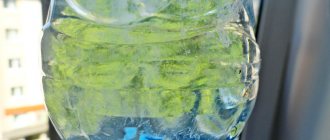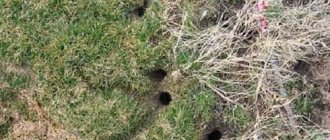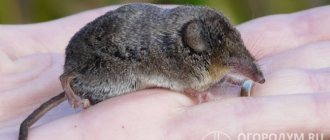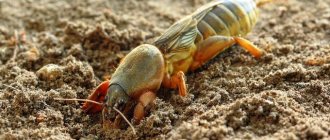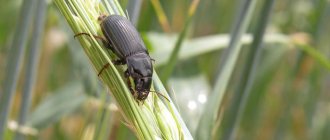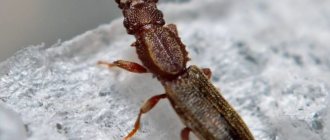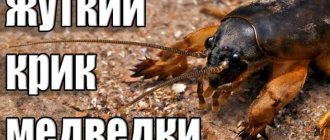So why is it called that?
The fact is that the dung fly lays eggs in cattle manure.
Undoubtedly, this is the place where the required temperature is maintained for eggs and larvae. After about a day, the eggs hatch into larvae, which, by the way, also do not eat manure, but get the opportunity to hunt the larvae of other insects. The population numbers about five hundred species. Therefore, the dung fly may not always hatch its larvae in manure. Some species develop in plant stems, algae, etc.
The larvae of some species of dung flies lead a “vegetarian” lifestyle - they are hatched in the leaves of plants. The fly lays eggs, attaching them to a leaf. After a while, a larva appears that mines the leaves, that is, it gnaws holes inside the leaf. Then it pupates, and after a while a new dung fly emerges from the pupa.
First aid for burner bites
Harmful insects most often choose helpless victims among people - small children, disabled people, sleeping people. They usually bite on the legs. Due to the poisonous saliva injected into the wound, a burning sensation and swelling appears.
The injured person must be given first aid:
- Cool the affected area by applying ice.
- Treat the wound with an antiseptic.
- Soda lotions are recommended to relieve itching.
- People prone to allergies should be given an antihistamine.
- If a day or two after the bite the victim feels unwell, he should go to the hospital. Possible infection.
How dangerous are flies?
Before we move on to describing methods of fighting flies, let’s figure out why such a neighborhood is dangerous.
- Moving from place to place, they land on food, infecting it with harmful microbes, which can cause not only severe poisoning, but also death.
- The habitat is perfect for the spread of diseases. During their life, flies land on garbage, dirt or feces. These bacteria are then transferred to food.
- Here are just some of the illnesses that are carried by these insects: diarrhea and dysentery, typhoid fever and typhoid fever, conjunctivitis and cholera.
- They are sources of salmonellosis, tuberculosis and ulcers.
Variety of species
In addition to the usual housefly, there are many other types of flies: field flies, fruit flies, dung flies, flies, tsetse flies, silver flies, etc. These insects are distinguished by great diversity in appearance, feeding habits, behavior and degree of danger to people and animals. Based on such diversity of species, the question arises, what are flies for? After all, in nature nothing exists for nothing, but necessarily has some kind of beneficial or harmful effect.
The main diet of flies consists of:
- food waste that remains after a person;
- mucous secretions and excrement excreted by animals and humans;
- blood of mammals;
- vegetable juices.
Flies spend almost their entire lives searching for food, often visiting toilets and contaminated places where rotting animal carcasses or spoiled fruits lie. Then flying into apartments through windows and doors, they land on food and any surfaces in the kitchen and rooms, carrying infection and harmful bacteria on their paws. Therefore, most people consider them carriers of various diseases and dangerous infections.
Some types of flies that feed on the blood of animals (tsetse, zhigalka, etc.) are capable of spreading deadly diseases (anthrax, trypanosomiasis, etc.) when they bite and pierce the skin. However, these insects can cause more than just harm to people and animals. Numerous studies have shown that flies are beneficial in nature.
Short description
Dung flies have an average size of 5-10 mm. Their body is slightly elongated and often has long, thick hairs. Both males and females have widely spaced eyes, behind which, as a rule, there are quite long light hairs. The species is distributed throughout the northern hemisphere, including forest zones, tundra and mountains.
Adults are predators. Most larvae are phytophages, but there are also saprophages and predators. The development of phytophages occurs in the stems of rushes, sedges, sorrel, reeds, as well as the lily and reed families. Some varieties cause significant damage to timothy and rye ears. About 10-20 species of these insects live on the territory of Russia.
Biology
The larval biology of this family is actually quite diverse, including plant feeders (miners, stem borers, or seed capsule feeders), aquatic predators, and predators of other insect larvae in wet situations—such as piles of decaying plant matter, marine algae or manure. Adults are predators of other small insects, and while they are often found on flowers, they hunt prey there rather than as pollinators. They are, in fact, one of the best predators of blow flies, thus making useful biological control agents. Some species are attracted to excrement in large quantities. One of the most famous species of this family is Scathophaga stercoraria (Linnaeus). The reddish-brown, densely haired males of this species dung on cattle and may, in some parts of its range, be observed at all times of the year.
Worldwide, about 500 described species are placed in 66 genera. The vast majority are found in the Palaearctic and Nearctic regions and the family is almost limited to the Northern Hemisphere with only five species still known from the Southern Hemisphere (and two of these are common northern Scathophaga species that were probably imported with livestock in South Africa and Brazil ). The most diverse fauna is found in the Far East, and many new species have been described in this area over the past few decades. Due to the northern distribution of many species, even within the Holarctic, Vockeroth (1987) described it as the northernmost distributed of all flight families. He reports that of the 150 species recorded in Canada, 25 are confined to the Arctic tundra.
Fifty-four species are currently recorded from the British Isles, and almost all of them have a Holarctic distribution.
Appearance of an insect
The dung beetle looks unusual for a fly. Her body is completely covered with fluffy hairs of brown or reddish color. Body length is 10-15 mm. Three pairs of limbs and two transparent wings correspond to the usual structure of insects belonging to the Diptera family.
An enlarged photo of a dung fly clearly shows large round compound eyes, widely spaced from each other. The organ of vision has a red tint. There are long antennae on the front of the head. The species' identity as a predator is revealed by its well-developed jaws and powerful forelimbs with spines. With them the dung fly grabs its prey.
What does it eat?
The dung fly is a predator. The food source is invertebrate organisms. She attacks other insects, including flies, holding her prey with her front paws and destroying it with a lightning-fast bite of her powerful jaws. Often the dimensions of the prey exceed the size of the predator itself.
Places of residence
Dung flies are predatory insects; they do not live in human dwellings, since there is no food suitable for them there. Therefore, you can only meet them in a residential building if a green fly flies there by accident. They visit places where livestock are kept to conceive and reproduce offspring (males await females on fresh manure).
According to entomological scientists, pig manure and feces of heifers feeding on milk are most preferable for this type of fly. It is in such an environment that the temperature necessary for the normal development of larvae is maintained for a long time. In addition, this manure remains fresh for a long time, unlike horse manure, which dries out quickly.
Anatomy of a fly - external structure
The general plan of the structure of dipterans, the skeleton of a fly is the same as that of other insects - head, chest, abdomen. The head contains the mouthparts, antennae, and eyes. The chest consists of three segments, with a pair of transparent wings, and three pairs of legs. The space in the chest is filled with powerful muscles. The abdomen includes most of the digestive organs and the reproductive system.
On a note!
Flies have pronounced sexual dimorphism, when the appearance and structure of the female differs from the male.
Fly head
Includes the organs of vision, nutrition, and hearing.
- Oral apparatus. Regardless of the differences in nutrition of many species of flies, their oral apparatus is represented by a proboscis of a sucking, licking type. A pair of extended blades of the upper and lower lips come into contact with food. The fly's jaws are powerful. Numerous tubules converge in the fly's proboscis, at its central point. The mouthparts of a fly that feeds on blood are additionally equipped with hard, sharp scales that serve as teeth and help pierce the skin of animals and humans. The liquid is drawn into the head using a pharyngeal pump.
- The eyes occupy most of the head. They form a complex system, which was taken as the basis for the development of a modern photo camera. They consist of many simple eyes that look like a faceted mesh from the outside. The insect receives a comprehensive but mosaic image of objects. Each eye includes several hundred or thousands of facets. The housefly has about 4 thousand of them. Many species have 3 simple eyes located on the crown of the head. This structure allows you to instantly capture movement, but does not provide a complete picture of the image.
- Mustache. A kind of antenna serves as a landmark. They help to catch odors and determine the direction of movement. In the process of evolution they changed, there are differences in males and females.
Interesting!
Males always have larger eyes than females. This allows them to react faster to movement and better assess their surroundings. Females have a more developed olfactory system, with the help of which they find a favorable environment for laying eggs.
The structure of a fly's head
Breast
Consists of three segments - prothorax, midthorax, metathorax. The bones of the fly and the main part of the muscles provide flight, so the middle part is the most developed. How many legs does a fly have? 3 pairs. Each consists of 5 parts and has its own powerful muscles. The structure of the fly's paws ends with claws and suction cups, which allow the insect to stay on a vertical, horizontal surface and even upside down. When walking, the soft pads compress and secrete a sticky secretion. This feature helps flies to hang on and move freely on window glass and smooth surfaces.
On a note!
The paws are one of the main sense organs - smell. Using its legs, the insect determines the taste of food and analyzes the quality. After a few seconds of analysis, it begins to feed or flies away.
Wings of a fly
The upper ones are well developed, transparent, membranous. The posterior pair is deformed into appendages - halteres. They maintain balance in flight, allow them to hover in the air, and also make a buzzing sound. Thin wings are reinforced with cylindrical veins.
Interesting!
During the flight, an insect can turn off one or the other wing, abruptly change its trajectory, perform complex maneuvers, and take off without preliminary acceleration. The structure and abilities of the insect were taken as the basis for many flying structures in airplanes and helicopters.
Abdomen
It has a cylindrical shape, elongated, consists of 10 segments, includes the organs of the fly responsible for reproduction, respiration, nutrition and other important functions. The elastic chitinous cover expands as food arrives during pregnancy. Therefore, the weight of the fly varies depending on these conditions.
Interesting!
An ordinary housefly or housefly weighs 12 mg; during pregnancy, the weight increases to 15 mg. Your weight can increase to the same level after a meal. The male is smaller, weighing about 12 mg. One gram contains about 80 of these insects.
The face of a fly can be easily seen under a microscope, but even when carefully examined with the naked eye, one can see an elongated mouthparts and large eyes of green, red, yellow, brown, and blue. The ears of a fly are located on different parts of the body and help to detect air vibrations and ultrasound.
Internal structure
The characteristics of the insect include its internal structure. Many people are interested in how a fly breathes and whether it can think.
Reproductive system
The genital organs are located in the abdomen. Like other living creatures, they consist of ducts, accessory glands, eggs or testes, depending on the gender of the insect.
External appendages vary depending on the species of Diptera. Flies lay from 60 to 160 eggs. Some species of winged pests are viviparous. They give birth to maggots.
Digestive system
The abdomen contains most of the digestive organs:
- water tubules;
- intestines;
- goiter.
In fact, the insect lacks a digestive organ. Food is digested before it enters the abdomen. The insect secretes secretions while absorbing food. She digests the “food”.
Other organs
Insects do not have such complex systems as humans. The brain helps coordinate movement. In this case, an organ such as the reflex arc is responsible for reflexes. The brain contains several thousand neurons.
Important: the fly has no intelligence and memory only retains information for the last 3 seconds.
The insect's body contains 10 pairs of spiracles that allow the pest to breathe. Oxygen enters each organ through its own spiracle.
What does it look like
The dung beetle is a red fly no larger than 1-1.5 cm in size. The cylindrical body is covered with thick gray or reddish hair, which in appearance resembles a kind of “fur”. On the small head, large, widely spaced eyes with a red-brown tint, as well as antennae, are clearly visible. At the base of the wing, only one scale is well developed. The insect's forelimbs have long spines, thanks to which it holds its prey when it captures it (a photo of a dung fly is shown below).
Features of the insect
Wohlfarth's fly is quite often referred to as tungsten fly. However, the last name is incorrect. The insect is named after Wohlfarth, the doctor who first (in 1770) described this very dangerous creature. The body structure of the Wohlfarth fly is similar to that of an ordinary housefly, but everything is presented in enlarged sizes.
- An individual of this species is a large insect of a light gray color, the body size of which can be up to 14 mm in length.
- On the mesonotum, 3 dark longitudinal stripes are clearly visible; black spots are also present on the sides of the ovoid abdomen.
- On the silvery head there are compound eyes, painted in dark red, and it also has black antennae and a licking proboscis.
- The insect has well-developed transparent wings. The entire body and limbs are covered with stiff hairs.
- Individuals of different sexes differ in the structure of their genital organs. Males also have a wider forehead (photo of a Wohlfarth fly is presented below).
Wohlfart fly
Where does it live?
Science knows about five thousand species of dung beetles, most of which live in the Palearctic, North America, and Mexico. Together with livestock, the insects found their way to Brazil and South Africa. Up to two dozen species of these insects live on the territory of the Russian Federation.
Dung fly
On a note!
The dung fly is a lover of moisture: it can be found in lowland forests, mountain meadows, coastal vegetation, swamps, peat bogs and even in the southern tundra.
Taxonomy[ | code]
Scathophagidae, together with flies from the families Fanniidae, Muscidae and Anthomyiidae, constitute the superfamily Muscoidea within Calyptratae. The position of the Scathophagidae within Muscoidea is debated and they are considered either (i) as the sister group to the Anthomyiidae (Bernasconi et al. 2000a), or (ii) as the sister group to all other Muscoidea (Mcalpin & Wood 1989), or (iii) as a subclade within subfamily rank within Muscidae or Anthomyiidae (Hackman 1956; Vockeroth 1956, 1965, 1989).
Classification | code
There are 420 species from 58 genera. Five genera are classified into the subfamily Delininae ( Americina, Delina, Leptopa, Mirekiana, Micropselapha
).
- Acanthocnema
- Acerocnema
- Aceronema
- Allomyella
- Amaurosoma
- Americina
- Bostrichopyga
- Bucephalina
- Cerastinostoma
- Ceratinostoma
- Chaetosa
- Cleigastra
- Cochliarium
- Conisternum
- Cordilura
- Cordylurella
- Cosmetopus
- Delina
- Ernoneura
- Eupteromyia
- Gimnomera
- Gonarcticus
- Gonatherus
- Gymnomera
- Hexamitocera
- Huckettia
- Hydromyza
- Jezekia
- Langechristia
- Leptopa
- Megaphthalma
- Megaphthalmoides
- Mirekiana
- Milania
. - Microprosopa
- Micropselapha
- Miroslava
- Mixocordylura
- Nanna
- Neochirosia
- Neorthacheta
- Norellia
- Norellisoma
- Okeniella
- Orchidophaga
- Orthacheta
- Paracosmetopus
- Parallelomma
- Phrosia
- Plethochaeta
- Pleurochaetella
- Pogonota
- Sargella
- Scathophaga
- Scatogera
- Spathephilus
- Spaziphora
- Staegeria
- Suwaia
- Trichopalpus
Reproduction and development stages
For mating, adult dung beetles choose rooms or places where there is an abundance of manure - a barn, a pigsty. Males organize competitions to see who can impregnate the female first. After mating, she lays her eggs in a pile of manure, where they are warm and protected for 24 hours. The saprophagous larvae that are born continue to live in this organic fertilizer, but they feed on the larvae of other insects in the neighborhood.
Interesting!
The dung fly prefers to raise its offspring in the waste products of pigs. Their manure retains its heat and soft consistency longer.
Dung fly
Some species of dung beetles lay eggs on the stems of plants and algae. Most often, a dung female chooses the following plants for her offspring:
- sorrel;
- reed;
- rye;
- lilies and others.
The emerging larvae are called phytophages. They bite into the leaves and make internal passages in them, feeding on the juicy pulp. After a few days, the fed caterpillars turn into pupae and freeze in this state. An adult will soon emerge from them.
Life cycle
Cicadas are relatively long-lived insects. A group of periodical cicadas can have a total lifespan of up to 17 years. But the imago lives only for a few months and the main goal of the adult is to find a partner for reproduction. All periodical cicadas are North American species.
Life cycle of a cicada
In terms of the level of harm, periodic species do not reach the level of real locusts, but it is better not to plant young trees before their departure. Old plants easily tolerate the mass appearance of insects.
Song cicadas live shorter lives. But the underground period of their development is very poorly studied. Most likely, the time of underground development of the larvae is 1-2 years.
Harm and benefits of dung flies
Predatory insects do not cause direct harm to humans. Despite the possible infection of a fly with bacteria, it very rarely enters a person’s house and will try to leave it quickly. Saprophagous larvae control the number of other larvae through their activity. Farmers note that a large number of flies in the barn begin to bother their domestic animals, crawling into their eyes and ears.
Phytophagous larvae cause damage to plants in which they are active. But serious damage to green spaces by caterpillars is rarely observed. When there is a sharp increase in the number of insects in a certain area, farmers use insecticides and other means to combat them
Are dung flies harmful?
The dung fly itself is not a pest for humans. Although it crawls through manure, it rarely flies into homes, so it does not have the opportunity to spread pathogenic bacteria. The insect also does not pose a threat to animals.
But sometimes there are too many flies, and they can begin to bother the animals, getting into their eyes and ears. That’s when farmers have a question about how to reduce the number of annoying insects.
In addition, leaf miner larvae are a serious problem for gardeners, as they damage plant leaves by digging tunnels through them to move around.
Piedwings
This is a family of spotted wing flies. Most of them are small, only a few mm in length. Some species can reach 2 cm. They are harmless to humans, but cause serious damage to crops.
The list of variegated flies includes the Mediterranean fruit fly with a red belly, which is exotic for Russians. Due to its size (up to 5 mm) and similar coloration, the details of which are difficult to distinguish without a microscope, this fly can easily be confused with Drosophila.
The Mediterranean fly is not among the Russian pests, but can be imported along with citrus fruits - the main food for its larvae.
Common subspecies of flies
At first glance, it seems that the flies are all the same - the same as we are used to chasing them around the house. But their population has exceeded 3,600 species!
Here are the most common types of flies:
House fly or house fly
It is the most common insect living near people. This specimen is not blood-sucking and practically does not bite, which still does not make it safe.
The body is painted dark gray; on the belly there are limbs with tentacles that actively carry bacteria and dirt that are dangerous to humans, which provokes infection with various infections.
The size of a housefly, as a rule, does not exceed 8 mm. Oddly enough, males are usually much smaller than females. A distinctive feature of the domestic specimen is a broken vein on the wings just before the edge.
Green or carrion fly
This unpleasant, but quite colorful creature can be found in garden plots, near peat or manure. They prefer habitats near sewage with a specific odor.
Ilyinitsa-beekeeper
A rather large specimen (1.5 cm), dark in color, covered with numerous fluffy hairs.
It is dangerous because if the larvae accidentally enter the human body, serious intestinal diseases arise.
Fly ktyr
A huge predator that eats midges, mosquitoes, etc. Unlike its fellows, the insect brings great benefits to humans, exterminating unnecessary pests and dangerous insects.
Their habitat is any rotting food, where there are other small insects and larvae on which it feeds.
Tsetse fly
Lives in the vastness of Africa and feeds on the blood of cattle and wild animals.
Notes
- Life of animals. Volume 3. Arthropods: trilobites, chelicerates, trachea-breathers. Onychophora / ed. M. S. Gilyarova, F. N. Pravdina, ch. ed. V. E. Sokolov. — 2nd ed. - M.: Education, 1984. - P. 411. - 463 p.
- ↑
- Narchuk E.P.
Key to the families of dipteran insects (Insecta: Diptera) of the fauna of Russia and neighboring countries (with a brief overview of the families of the world fauna). - St. Petersburg: Zoological Institute of the Russian Academy of Sciences, 2003. - 252 p. — ISBN 5–98092–004–8. - ↑
- ↑
- ↑
- Mamaev B. M., Medvedev L. N. and Pravdin F. N.
Key to insects of the European part of the USSR. - M.: "Enlightenment", 1976. - P. 248-284. — 304 p. - Bisby FA, Roskov YR, Orrell TM, Nicolson D., Paglinawan LE, Bailly N., Kirk PM, Bourgoin T., Baillargeon G., Ouvrard D. (ed.).
(English).
Species 2000 & ITIS Catalog of Life: 2011 Annual Checklist
(24 September 2012). Retrieved August 2, 2022.
| This is a draft article on entomology. You can help the project by adding to it. |
Do dung beetles live in apartments?
Since dung beetles are predators, they usually have nothing to eat in the house. Therefore, they are extremely rarely found in a person’s home, unless a fly flew into the house purely by accident.
Corrals for livestock are their habitat only during the mating season, when it is necessary to conceive and breed offspring. At this time, male dung flies flock to fresh dung and wait for females. When they appear, sometimes several gentlemen rush to one lady at once, trying to preserve their gene pool.
Entomological scientists have found that the most preferable for flies is the manure of pigs, as well as the manure of young calves feeding on milk. It stays fresh the longest and maintains the necessary temperature for the life and development of larvae, while horse manure dries out quite quickly.
Hoverfly or syrphid
Very similar to a wasp. In the summer, you can see such a fly hovering over flowering plants, or near a cluster of garden aphids.
This specimen is safe for humans. It feeds on the nectar of inflorescences and spider mites. The buzzing of a fly resembles the sound of rushing water, which is why it got its beautiful name.
Methods for controlling flies
It is best to use insecticides containing pyrethrum as a last resort. The fact is that pyrethrum is very toxic; to work with it, it is necessary to take precautions such as a respirator and gloves, in addition, it is necessary to protect exposed skin. The use of such a product can affect domestic animals, as well as plants, so it is necessary to strictly follow the instructions and take into account the proportions.
In this case, the flies will die after the first spraying, but the larvae and eggs have increased endurance, so in any case more than one treatment will be required.
Methods for controlling dung beetles include:
- removal and destruction of affected leaves;
- growing plants under a cloth that prevents the penetration of flies;
- Regular cleaning of pens where livestock are kept.
In addition, do not forget about such methods of getting rid of flies as regular sticky tape. Velcro hanging in the barn will be able to control the number of insects for some time. An effective way to combat them can be laurel oil, which should be rubbed onto window frames, as well as doorways in the pen. The smell of laurel oil repels dung beetles, as well as many other pests.
Flies that are beneficial: do they exist?
Certainly. Many flies destroy spoiled food, eat carrion, and dispose of garbage. They are sanitary insects. Without them, humanity would be mired in decay and stench. Even synanthropic flies, the same ones that live in close proximity to humans, are not all harmful. And, if you don’t take into account horse flies, horse flies and common household parasites, there are beneficial species among them.
Sewers are the best place for insects to live. Fly larvae are hard at work here, destroying waste products. Considering that feces are the source of many infections, this is useful and necessary work. That is why it cannot be said that the dung fly is a useless pest.
Blue blowfly
Now about carrion flies, or blow flies. There are a lot of them. In addition to the well-known green fly, there is a blue meat fly and a striped fly (also known as a gray meat fly). Most are viviparous, laying maggots directly into dead flesh. They are considered orderlies. By the way, the gray one is a big fly; it is larger than many of its relatives and immediately catches your eye.
hoverfly
There are also fly predators. For example, ktyr is a fly that destroys mosquitoes and midges. It is not at all dangerous for humans, but small gnats noticeably suffer from this assistant. The hoverfly is a cute creature, not similar in appearance to its relatives. It has very predatory larvae that feed on small soft insects, mainly aphids. Adults resemble wasps in appearance. The photo shows how attractive hoverflies are. Close to them is the wasp fly.
Beekeeper
The bee-eater is no less attractive. It is related to hoverflies, but not predatory. The fly feeds on nectar and is a pollinator. But the beautiful, yellow bee can also be harmful: if its larva gets into the human intestines, it will become a parasite.
Spanish fly - a poisonous beetle
But what about the Spanish fly, which many have heard about. The insect has its own interesting history. It is believed to cause strong sexual arousal. Surprisingly, the Spanish fly has nothing in common with flies. This is a beetle, and it has a very beautiful emerald, iridescent color. The Spanish fly belongs to the blister family: when attacked, it secretes a liquid that greatly irritates the surface tissues. The insect smells like mice. On its basis, the drug “Spanish Fly” is produced, which is still considered an aphrodisiac. The product was also used to enhance potency, but it turned out that it had a bad effect on the kidneys and liver. Currently, Spanish Fly is one of the most famous drugs that cause sexual desire.
Cicada
There are a huge variety of flies, and they are all different. We talked about only a few species, including the melon fly, African fly, cabbage fly, zhigalka and others. There is also an insect called the cicada, which is often confused with the heroine of the story. And it’s clear why. The cicada looks like a fly, although in fact it is not one. This is a beautiful, large insect that can sing. The chirping of the cicada can be heard both at night and during the day. She prefers hot climates. Belongs to the order Hemiptera. And although the cicada resembles a fly, it leads a completely different lifestyle.
Black soldier fly
In addition to those listed, there are many more types of insects. For example, Swedish fly, red fly, mangrove fly, earth flies, black soldier fly and others. These constant, close companions of man have left their mark even in culture: the phraseological unit “white flies”, denoting falling snowflakes, is directly related to insects and is quite poetic. We think it’s worth reconsidering your squeamish attitude and getting to know them better. And perhaps you will discover a lot of interesting things.
Horsefly
But blood-sucking horse flies attack humans and livestock very actively, often in large numbers. Their bites are very painful, and the bite site swells greatly due to saliva and anticoagulants injected under the skin (and the latter also contribute to prolonged bleeding from the wound).
And this is not just an unpleasant process - horsefly bites transmit many dangerous diseases to humans and livestock, from anthrax and tick-borne encephalitis to tularemia, listeriosis, dermatitis and allergies.
Externally, the horsefly is not difficult to identify - it is a large (up to 3 cm long) two-winged insect with a dark, sometimes striped, flattened body and huge eyes. They fly very quickly and can actively attack people, especially in the hottest part of the day and when the skin is moistened with water or sweat - during swimming, physical work in the air, or simply when being near bodies of water.
Prevention
Of course, it is always easier to prevent a problem than to fix it. Therefore, it is necessary to maintain basic sanitary and hygienic conditions:
- dispose of household waste in the house in a timely manner;
- do not leave uncovered food on the table;
- place a mosquito net on the windows;
- Clean pet pens regularly;
- examine animals for wounds to avoid infection with green fly larvae;
- treat manure heaps with biothermal agents;
- promptly dispose of the corpses of dead animals, as well as pests such as rats, moles and others;
- Disinfect latrines with insecticides.
Tansy essential oil repels flies, causing paralysis of their limbs. Bouquets of these flowers, hung in a livestock room or standing in a vase in an apartment, will help get rid of annoying flies for a long time.
Classification of flies by nutrition
Lifestyle shapes nutritional habits. There are several types:
- Afagi. Adults do not feed and live no more than 14 days. The larvae develop and parasitize on humans and animals. A striking representative of aphages are gadflies.
- Nectarophages. Adults feed on plant juices, droppings, and excrement. The larvae develop in a liquid medium, which serves as food for them. Obligate parasites of animals, rarely found on humans. Wohlfart's fly.
- Coprophagous. Adults and larvae feed on excrement. Additional food is plant juices. This species includes pasture flies of the Muscidae family.
- Coprophagous facultative. Maggots develop in excrement, manure, rotten plants, and slops. Adults eat human food. The representative of the species is the house fly.
- Hematophages are obligate. Mature insects feed on blood. The larvae develop in manure, feces, decaying remains of plants, corpses, and feed on the same. This includes the Autumn Zhigalka, which, with the onset of cold weather, makes its way into the house, displacing its indoor relatives.
- Hematophagous facultative. For sexually mature individuals, food consists of secretions from mucous membranes, sweat, and blood protruding from wounds. They cannot bite themselves; their mouthparts are not suitable for this. Additional food is excrement. Maggots also develop there. This species includes the Market fly.
- Necrophages are facultative. Adults feed on decomposing corpse tissue, meat, food waste, juices, and excrement. In most cases, larvae develop in meat. Capable of parasitizing wounds of animals and humans. A striking representative of this species are blowflies - green, blue, gray.
- Polyphages. The diet is very diverse - excrement, body secretions, blood, food waste of animal and plant origin. The larvae adapt to any environment where there is the possibility of feeding. Houseflies are called polyphages.
On a note!
The house fly is a nuisance in residential areas from the beginning of May to the end of July. These are the flies that don't bite. In August they are replaced by zhigalki. They are distinguished by their aggressive disposition, wings protruding to the side, extreme activity, and painful bites. The pest disappears with the onset of persistent cold weather.
Biology
Adults of calliphorid flies are, as a rule, brightly colored green or blue with a metallic tint; less often dark gray with brown.
Typically carrion flies that develop on corpses are representatives of the main genera of the family - green carrion flies (Lucilia) and blue carrion flies (Cynomya, Calliphora). Their females require a significant amount of protein (up to 800 mcg) to develop eggs. Having found carrion (sometimes the fly has to fly up to 20 km to do this), females lay white eggs measuring 1.5x0.4 mm - 150-200 eggs at a time. In total, a female can lay up to 2000 eggs in her life. For the larvae to hatch, it takes from 12 hours to 1-2 days (depending on the ambient temperature). Digestion in larvae is extraintestinal - they absorb food liquefied by their proteolytic enzymes.
There are two types of carrion fly larvae: smooth and “hairy”. The first are exclusively scavengers; the latter are predominantly active predators, feeding on smooth larvae, and appear on carrion later than the former.
The larvae go through three moults and then pupate. At room temperature (approx. 30 °C), the black carrion fly Phormia regina transforms from egg to pupa in 6-11 days. The larva burrows into the ground and, if the weather is favorable, emerges from the puparium after 14 days as an adult insect. Because the life cycle of carrion flies is well understood, they are used in forensic science to determine the time of death.
In addition to carrion, many species of carrion flies develop on the excrement of humans and animals. It is not uncommon for the same species to develop both on carrion and in feces. Feeding on decaying meat has created the preconditions for a number of species of carrion flies to transition to parasitism on living beings: pollen flies (Pollenia), for example, retain the ability to develop in meat, but their larvae are often found in the body of earthworms, which they gradually eat. There are species that parasitize snails and live in termite mounds and anthills. Parasitic carrion flies can develop in necrotic tissues and cause myiases in animals and humans. Thus, the damage caused to the Australian sheep industry by the fly Lucilia cuprina, which parasitizes sheep, is estimated at 170 million US dollars annually.
Adult carrion flies sometimes become pollinators of flowers, to which they are attracted by a strong smell, similar to the smell of rotting meat (like pawpaw).
Interesting facts about flies
- since ancient times, some healers have used fly larvae to treat neglected wounds, using their ability to eat away dead tissue; - flies were especially favored by the ancient Egyptians: the insect was considered a symbol of audacity and courage; — the voracious larvae of hoverflies eat over 2 thousand aphids during their development.
Sources
- https://klopkan.ru/muhi/navoznaya-muha-groznyy-hischnik-i-pomoschnik-cheloveka/
- https://TezarVape.ru/opasnye/muha-navoznaya.html
- https://beyklopov.ru/moshki/obschie/navoznaya-muxa.html
- https://dr-dez.ru/muhi/ryzhaya-muha.html
- https://kursi-floristiki.ru/muhi/golova.html
- https://apest.ru/muhi/vidy-muh/navoznaya-muha/
- https://notklop.ru/muhi/3-vidy/48-navoznaya-muha/
- https://FB.ru/article/262096/navoznaya-muha-sreda-obitaniya-foto
- https://zelenyjmir.ru/muxa/
- https://poklopu.ru/muhi/vidy-muh.html
- https://notklop.ru/muhi/3-vidy/39-vidy-muh/
[collapse]
